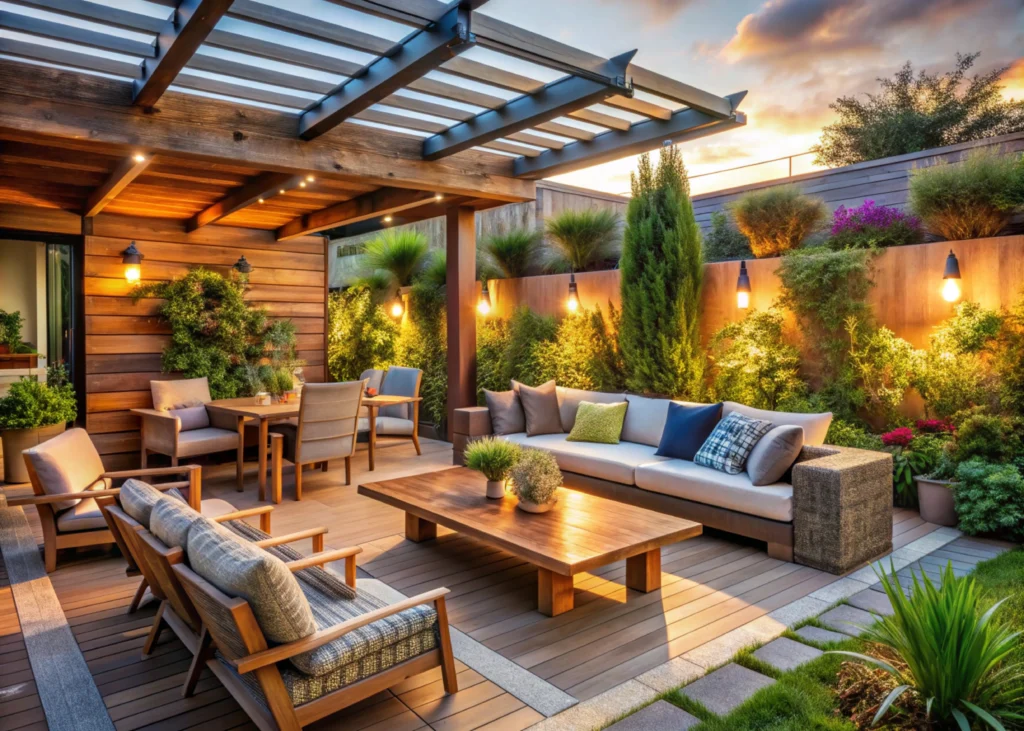The drawbacks of climate change are an open book for everyone and every organization, globally.
As landscapers and homeowners continue to become more eco-conscious, the demand for sustainable yard designs and practices is on the rise.
The concept of sustainable scapes revolves around creating outdoor spaces that are functional, beautiful, and eco-mindful.
This article looks at some of the key trends that drive this transformation.
Native Plants
The deteriorating climactic conditions have not only impacted atmospheric conditions, but water and soil biodiversities, too, are at risk of extinction.
In a broader support for sustainable outdoor spaces, homeowners should embrace indigenous in place of exotic plants.

Sustainable And Eco-Friendly Outdoor Design
The advantage with these is that they are resistant to pests and diseases thereby cutting the need for harmful chemicals that increase carbon footprint.
These types of plants also require very little watering, cutting the depletion of the crucial water resource. As a bonus, these plants perform well with minimal intervention, providing homeowners with unparalleled convenience.
Sustainable Hardscapes
If there is one area that is notorious for contributing to deforestation and climate change, is the outdoor space. While that has been the case in the majority of homes for a very long term, this has now seen a paradigm shift as people continue to explore alternative hardscapes. It is therefore common to see hardscapes made of sustainable materials including composite and reclaimed wood, bamboo, plastic for decking, and concrete for garden and yard paths. Permeable paths and driveways prevent heat island effects, promote water infiltration, and reduce landfill waste. In addition to promoting sustainability, these materials provide homeowners with an additional revenue stream, as they are cheaper than solid wood.
Composting and Mulching
Composting yard and garden waste such as twigs, grass clippings, leaves, and other organic matter reduces waste footprint and greenhouse gas emissions during decomposition. It also eliminates the need for chemical fertilizers as compost manure is used to replenish the soil, aiding in promoting healthy biodiversity. Mulching, on the other hand, aids in water retention, especially throughout hot summer weather, contributing to water scaling. Furthermore, mulching supports the breeding of soil organisms that make the soil fertile, cutting the need for chemical fertilizers.
Wildlife-Friendly Habitats
Research has it, that the entomological population is on an alarming decline, in the recent past. This can be attributed to the use of harmful farming chemicals including commercial pesticides and fertilizers. The effect of this is a lack of enough pollinators such as birds, and bees, among other organisms. Installing birdhouses, bat boxes, and beehives not only supports the ecological balance in your landscape but it also opens up to a beautiful outdoor space that is therapeutic to unwind in.
Xeriscaping
This refers to the act of reducing water consumption through drought-tolerant plants and efficient irrigation systems. Efficient irrigation systems such as programmable drip lines allow water to fall precisely on plants’ root systems, at the specified time, reducing the wastage of this crucial natural resource. Reduced water bills, reduced wastage, and less dependency on chemical fertilizers contribute to significant eco benefits. Effective gutter systems and rain gardens that absorb stormwater runoff help prevent soil erosion and flooding.
Eco-Mindful Outdoor Lighting
Grid outdoor lighting consumes lots of electrical energy, which leads to environmental degradation. What most people may not realize is that besides the environmental impact that comes with this type of lighting, it is cost-ineffective. Thanks to technology, we now have energy-conscious outdoor lighting that includes LED that consumes much less electrical energy than the common lights. Another great invention is the introduction of solar-powered outdoor lighting that utilizes natural light as a source of energy.
Edible Landscaping
One fast-rising green landscape practice is the blending of edible with decorative plants to create visually appealing and functional landscapes. Herbs like basil and mint growing alongside flowering plants in container gardens are a popular trend example. Integrating edible and food with decorative plants reduces food miles, promotes self-sufficiency, and minimizes packaging waste.
Modern yards are no longer just spaces of leisure; they are opportunities to reduce environmental footprints. Sustainable scapes enable homeowners to create greener, more responsible outdoor areas that reflect their eco-mindfulness values. Whether edible landscaping, xeriscaping, efficient outdoor lighting, native plants, composting and mulching, sustainable hardscapes, and wildlife-friendly habitats, these trends align beauty with sustainability, ensuring yards and other landscapes are as functional as they are environmentally friendly. Whichever your pick is among these, a landscaper will transform your landscaping ambitions to life. Furthermore, they will offer professional insight into what matches your preferences.




